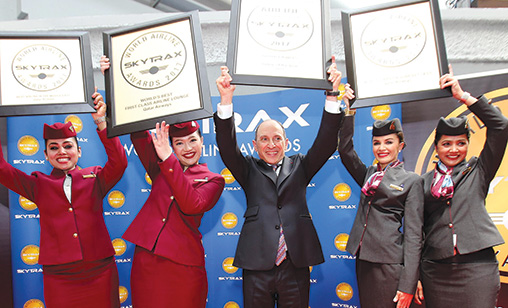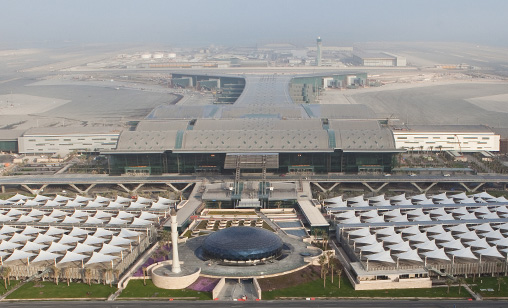News Analysis
A bad situation worsens in the Gulf
Middle East airlines have proliferated as aircraft are built that fly passengers further and faster, via the Gulf’s global gateways, to destinations worldwide. But their businesses are suffering as several governments fight to contain terrorism by restricting air travel from North Africa and the Middle East.
July 1st 2017
When the heads of the world’s airlines gathered in Cancun, Mexico for the International Air Transport Association’s 73rd annual general meeting last month it was evident something was amiss. Read More » For the first time in years, the president of Dubai’s Emirates Airline, Sir Tim Clark, was nowhere to be seen. Nor was the Etihad Aviation Group’s acting boss, Ray Gammell, although Etihad Airways CEO, Peter Baumgarten, was there.
Qatar Airways Group chief executive, Akbar al Baker, was very visible at the first of the AGM’s formal dinners and told colleagues he would see them the following day. But his arrangements suddenly changed. Overnight, he flew back to Doha after the news broke that the United Arab Emirates, Saudi Arabia, Bahrain and Egypt had expelled Qatar’s ambassadors from their respective countries and also severed diplomatic relations with their Middle East neighbor.
 |
Collectively, the four states said the decision had been made because the Qatari government was actively aiding terrorism, an accusation that remains in place at press time. The four nations also closed their airspaces to Qatar Airways and banned all flights to and from Doha from their territories. As a result, Qatar has ceased services to 18 cities, but has scheduled routes to other destinations to compensate for flight bans.
At press time, the four nations issued 13 new demands, including a cutback in diplomatic ties with Iran.
The politically charged turn of events in the Gulf became the hottest topic of conversation in Mexico. It was generally assumed that the absence of several senior Emirates and Etihad executives at the AGM indicated they knew about the bans and stayed home. Al Baker, it appeared, was taken totally by surprise.
But Qatar is not the only airline trouble spot in the Middle East. After years of break neck expansion, the Gulf carriers have hit a profit wall. The slowdown is reflected in the forecasts of the International Air Transport Association. It has predicted Middle East airlines will report a profit of US$0.4 billion this fiscal year compared with a $1.1 billion profit in the previous 12 months.
At Etihad Airways, the daring strategy of former Etihad Aviation Group CEO, James Hogan, is being rolled back as the group’s investments in its partner airlines have been mostly lost. Alitalia, which is 49%-owned by the Etihad Aviation Group, is in bankruptcy protestion. The Abu Dhabi airline group has refused to top up its investment in the Italian airline and its holding in airberlin is believed to be for sale. The launch of a European leisure airline, in partnership with the Tui travel group, has been abandoned. In Australia, Virgin Australia has fallen short in delivering a return on Etihad’s investment in the carrier.
In May, Dubai’s Emirates Airline, which is the Middle East’s largest carrier airline, reported an 80% net profit collapse, to $340 million for the fiscal year. The results, said the carrier, were due to European political upheaval, terrorist attacks and tougher travel restrictions to the U.S. The airline’s parent, the Emirates Group, said overall profits for the group had declined by 70%, to $670 million.
 |
President of Dubai Civil Aviation and chairman and chief executive of Emirates Airline and Group, Sheikh Ahmad Bin Saeed Al Maktoum, said the 2016 year was one of the company’s “most challenging years to date”.
“We remain optimistic for the future of our industry, although we expect the year ahead to remain challenging, with hyper competition squeezing airline yields and volatility impacting on travel flows and demand in many markets.”
The political ostracizing of Qatar, and consequently its flag carrier, has shocked the industry. The decision was announced only days after the carrier reported a 2016 financial year profit of $445 million, compared with a $103 million profit a year earlier. It was, said Al Baker, the airline’s best year to date.
But unless the bans on Qatar are reversed the carrier’s problems are multifarious. At present, its aircraft have to fly circuitous routes to avoid passing through UAE, Saudi Arabian, Bahraini and Egyptian airspace en route to their destinations.
Apart from additional fuel costs and longer flying times, the travel industry is reporting that passengers are switching from Qatar to Emirates and Etihad and that more cautious travelers are avoiding the Gulf altogether.
Since Dubai, Abu Dhabi and Doha rely massively on hub traffic transiting to destinations across the globe, the lap top bans alone have forced Emirates and Etihad to reduce their flight frequencies to the U.S.
Last month, Al Baker said: “This blockade is unprecedented and is in direct contradiction to the convention that guarantees rights to civil overflight. We call upon the International Civil Aviation Organization (ICAO) to declare this an illegal act. We are not a political body, we are an airline. This blockade has stripped us of the rights which are guaranteed to us.”
An official delegation from the UAE, Saudi Arabia, Bahrain and Egypt has visited ICAO headquarters in Montreal and met with ICAO Council President, Dr Bernard Aliu, and Secretary General, Dr Fang Liu.
| 'A statement issued after delegates from the four nations that imposed the bans on Qatar met with officials of the International Civil Aviation Organsiation, said the delegates responded to all the queries fielded by the international organization and they contested all Qatari allegations. They have presented circumstantial evidence, including maps and precise data proving that Qatar ports are open and their aircraft have full access to international routes and airspaces of other countries, and that the four countries have not imposed a blockade on Qatar. The delegates have reiterated their four countries’ sovereign rights to protect their airspaces against any threats or dangers' |
The delegation members affirmed the measures taken against Qatar were within their sovereign and legal rights under international law and the United Nations Security Council Resolutions No 2309 and 1373 on countering all forms of terrorism. They also comply with the Convention on International Civil Aviation “Chicago Convention 1994”, including all its complementary arrangements on regulating international air travel, they said.
At the Mexico AGM, IATA chief economist, Brian Pearce, said evidence was emerging that the U.S. and U.K bans on laptops onboard was impacting on Gulf air passenger traffic. “No matter what remedies are put in place, the bans are another hassle factor,” added chief economist at Ascend, a UK’s Ascend aviation consultancy, Peter Morris.
“What is worrying is that no timeline for remedies or reduction of bans exists and the rules for the U.S., the UK and Europe are clearly anomalous. The regional airlines’ U.S. markets are particularly hit by the bans,” he said.
But Emirates problems have not ended there. Last month, the Civil Aviation Administration of China (CAAC) fined the Dubai carrier US$4,270 for two incidents that “violated safety norms”. The carrier was banned from expanding its network onto the Mainland for six months. The CAAC said that on April 17, Emirates flew at a wrong altitude above Urumqi in Xinjiang after Emirates’ crew misunderstood instructions.
On May 18, the carrier’s radio communications were cut off over the same region. In a statement, an Emirates spokesperson said safety was a top priority for the airline and that the carrier will complete all actions required by CAAC.
The profit plunge at Emirates and the political and operational difficulties facing other Gulf carriers are signs of changing times. Speaking in Berlin in March, Emirates Airline president, Sir Tim Clark, said the world’s biggest long-haul airlines were facing a “gathering storm” as a new generation of low-cost carriers targeted the intercontinental routes on which the legacy carriers had built their businesses.
He said there were threats across all markets from Norwegian Air Shuttle to Singapore Airlines-owned Scoot. He also hinted Emirates may need to establish a short-haul fleet. “The dynamic is changing in the Middle East with regard to access to new markets. Our business model was set in the late 1980s, when access was denied to us by many places in the region,” he said.
While Norwegian Air has focused its long-haul development chiefly on trans-Atlantic flights, it also has a hub in Bangkok and will soon launch London-Singapore. Scoot plans to begin flights to Europe this summer, starting with Athens, a city that is also part of the Emirates network.
Clark, who has run Emirates since 2003, said he sees no immediate switch away from an all-wide-body fleet but “others coming behind may take a different view”. “Political and socioeconomic upheavals have created an environment in which running a global airline has become increasingly challenging.
“A decade ago, a major carrier might have faced disruptive events a couple of times a year, but the pace of change is accelerating and quite destabilizing,” he said.
 |
| 'You are not necessarily looking at the economies of Dubai or other Gulf nations. The fact is they are connecting most of the traffic going through, so you are looking at the economies of India, Latin America, the U.S. and Asia. I think their model does work. Someone suggested there may be too many hubs competing with each other, but in terms of traffic that’s up to them to sort out' |
| John Leahy Chief operating officer customers Airbus Commercial Aircraft |
At least one senior industry figure does not foresee any dramatic downturn for Gulf airlines. Chief operating officer customers for Airbus Commercial Aircraft, John Leahy, said it must be remembered that the Middle East is primarily a hub.
“You are not necessarily looking at the economies of Dubai or other Gulf nations. The fact is they are connecting most of the traffic going through, so you are looking at the economies of India, Latin America, the U.S. and Asia. I think their model does work. Someone suggested there may be too many hubs competing with each other, but in terms of traffic that’s up to them to sort out,” Leahy said.
He also does not see the global economy softening. “There’s a little bit of weakness in some regions, but the U.S. seems to be strong and Europe seems to be recovering. People have always predicted there could be a recession in China, but they have been predicting its collapse for years and it just keeps growing. So I don’t think you see any recession on the horizon,” he said.
Nevertheless, most airlines are reporting reduced profits compared with last year. Costs are rising and yields are weakening. Emirates said that in the past year, passenger yields dropped to 6.7 cents because of the weakening of all major currencies against the “relentless rise of the U.S. dollar”. In the case of Emirates, the strengthening US$ had a $571 million impact on revenue.
The Gulf carriers in particular are vulnerable to a fall-off in business travel demand from a sluggish global oil and gas market.
Hogan departed Etihad because the UAE sheikhs that own the airline were not happy with the losses from Hogan’s nascent alliance network.
At Emirates, the situation is different. Rumours have been circulating in recent months that Clark was planning a 2017 retirement but it is now being reported, also without any Emirates confirmation, that he will remain in his current position into 2018.
Earlier this year, when asked about Emirates’ succession plans, Sheikh Ahmad said: “If we look at the leadership that we have within Emirates, we have an excellent caliber of people working for the company for a long time. At any time, if we want to do any changes, we have many people that can fill the role.”
One thing is certain that whoever is running a Gulf airline in the future, he or she will be running it very differently from now.